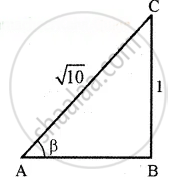Advertisements
Advertisements
प्रश्न
If tan α = `1/7`, sin β = `1/sqrt10`. Prove that α + 2β = `pi/4` where 0 < α < `pi/2` and 0 < β < `pi/2`.
उत्तर
Given that tan α = `1/7`
We wish to find tan(α + 2β)

AB2 = AC2 - BC2
AB2 = 10 - 1
AB2 = 9
AB = 3
sin β = `1/sqrt10 = "Opposite side"/"Hypotenuse"`
tan β = `"Opposite side"/"Adjacent side" = 1/3` (Here β is an acute angle)
Now tan 2β = `(2 tan beta)/(1 - tan^2 beta)`
`= (2 (1/3))/(1 - (1/3)^2) = (2/3)/(8/9)`
`= 2/3 xx 9/8 = 3/4`
Consider tan (α + 2β) = `(tan alpha + tan 2 beta)/(1 - tan alpha tan 2beta)`
`= (1/7 + 3/4)/(1 - 1/7 xx 3/4)`
`= ((1 xx 4 + 3xx7)/28)/(1 - 3/28)`
`= (25/28)/(25/28)` = 1
tan (α + 2β) = `tan pi/4 (because tan pi/4 =1)`
∴ α + 2β = `pi/4`
APPEARS IN
संबंधित प्रश्न
If sin A = `3/5`, 0 < A < `pi/2` and cos B = `(-12)/13`, π < B < `(3pi)/2`, find the values of the following:
- cos(A + B)
- sin(A – B)
- tan(A – B)
If cos A = `13/14` and cos B = `1/7` where A, B are acute angles prove that A – B = `pi/3`
Prove that 2 tan 80° = tan 85° – tan 5°.
Find the value of tan `pi/8`.
Find the value of sin 75°.
The value of sin 15° is:
The value of sec A sin(270° + A) is:
The value of 1 – 2 sin2 45° is:
The value of `(2 tan 30^circ)/(1 + tan^2 30^circ)` is:
If tan A = `1/2` and tan B = `1/3` then tan(2A + B) is equal to:
